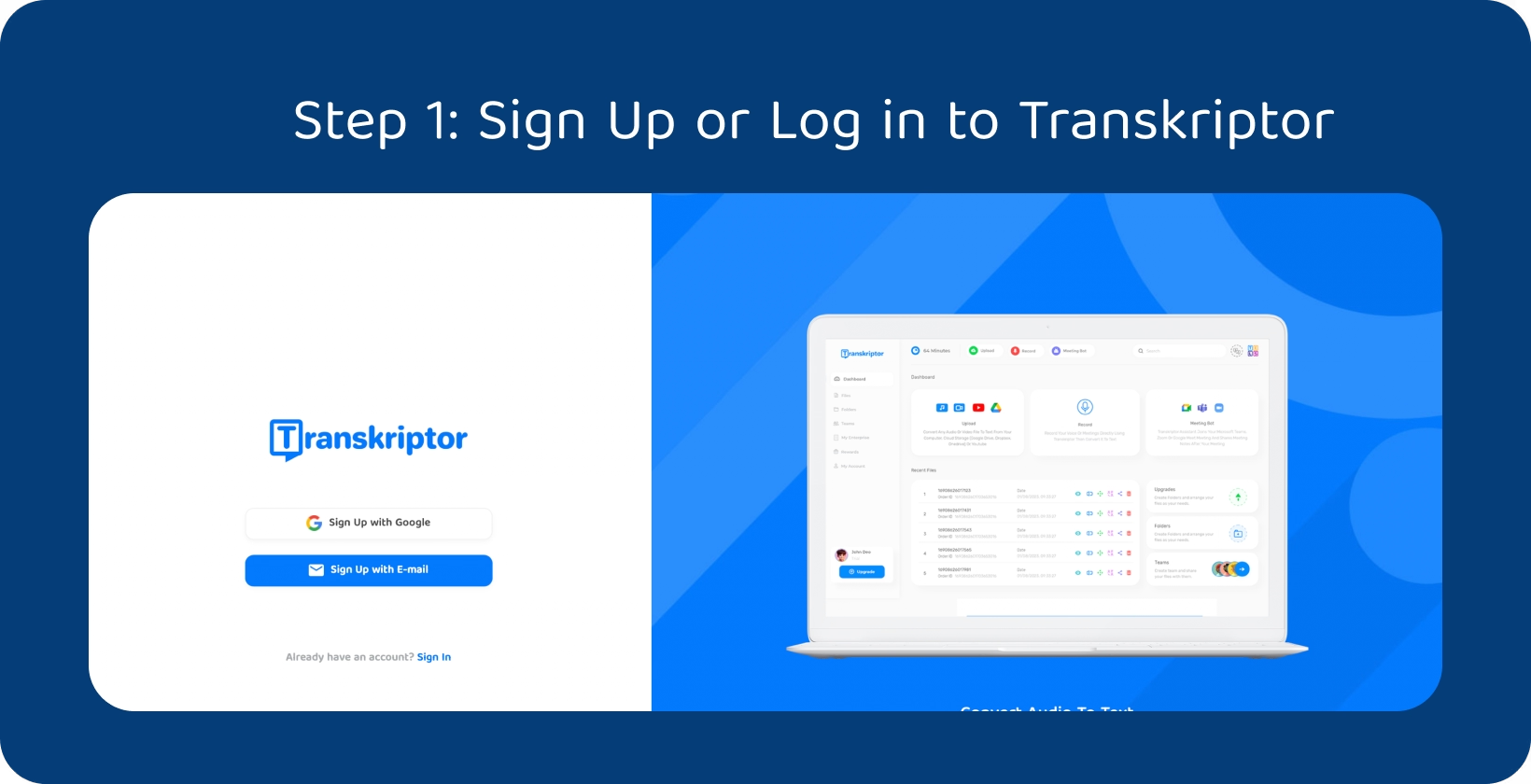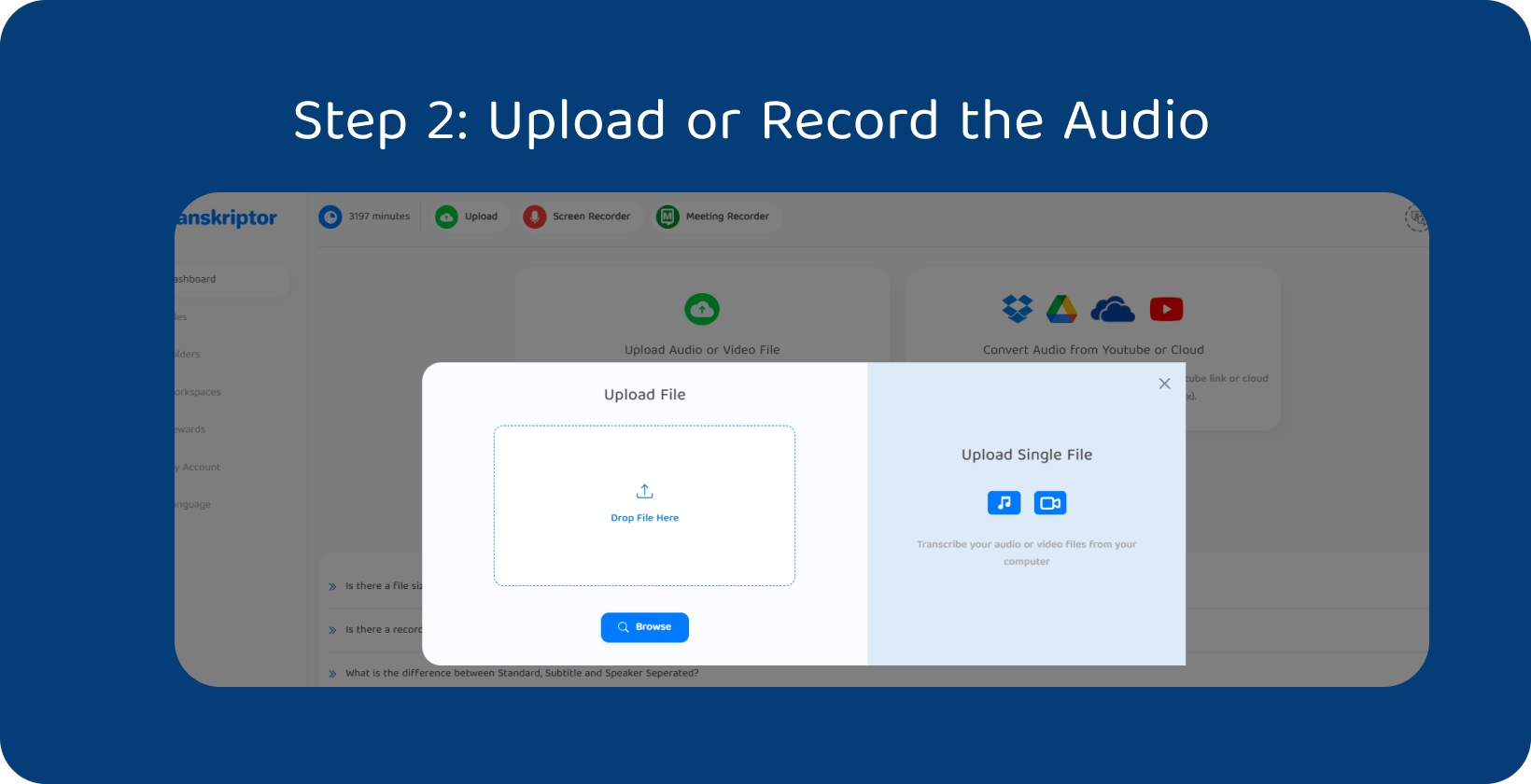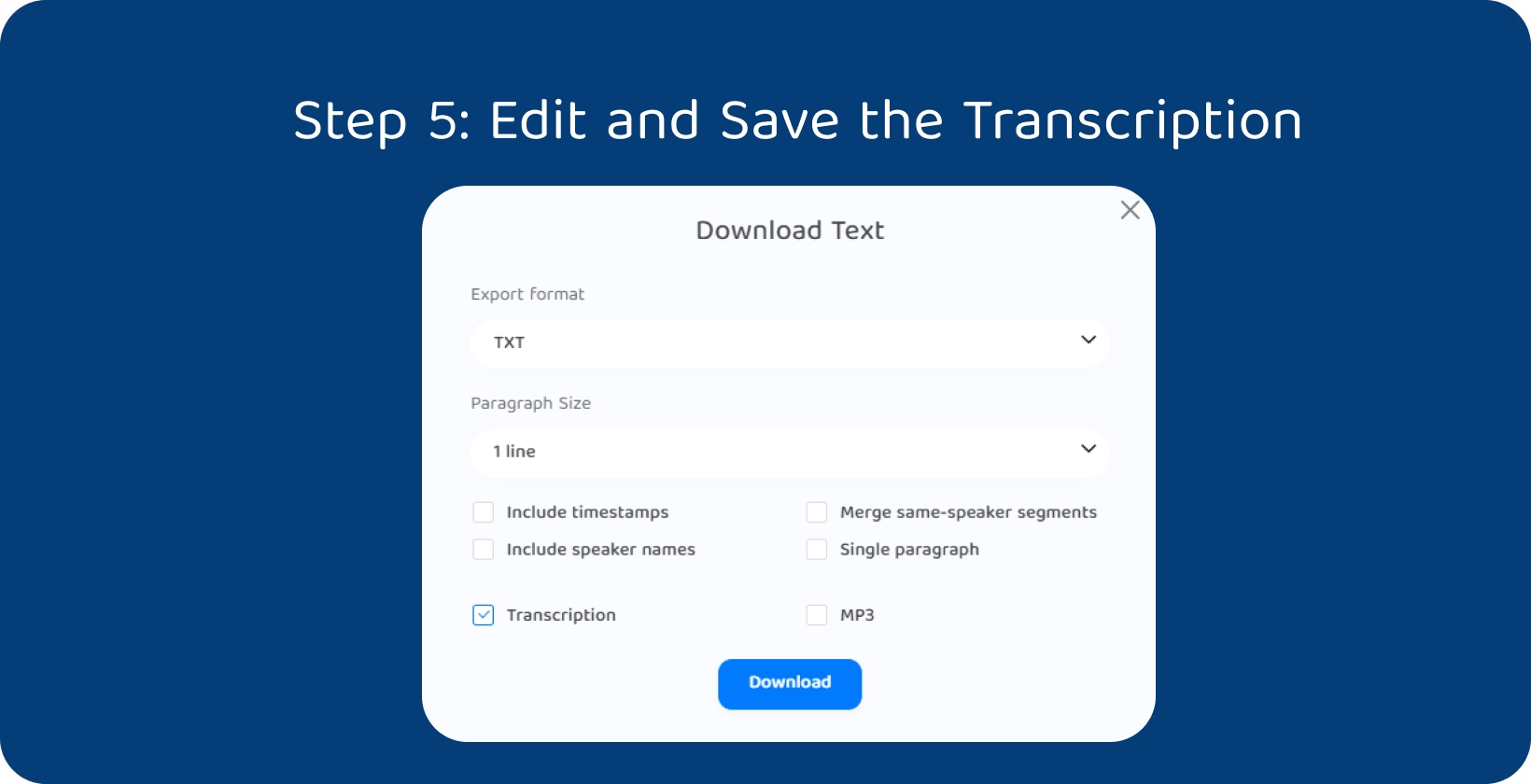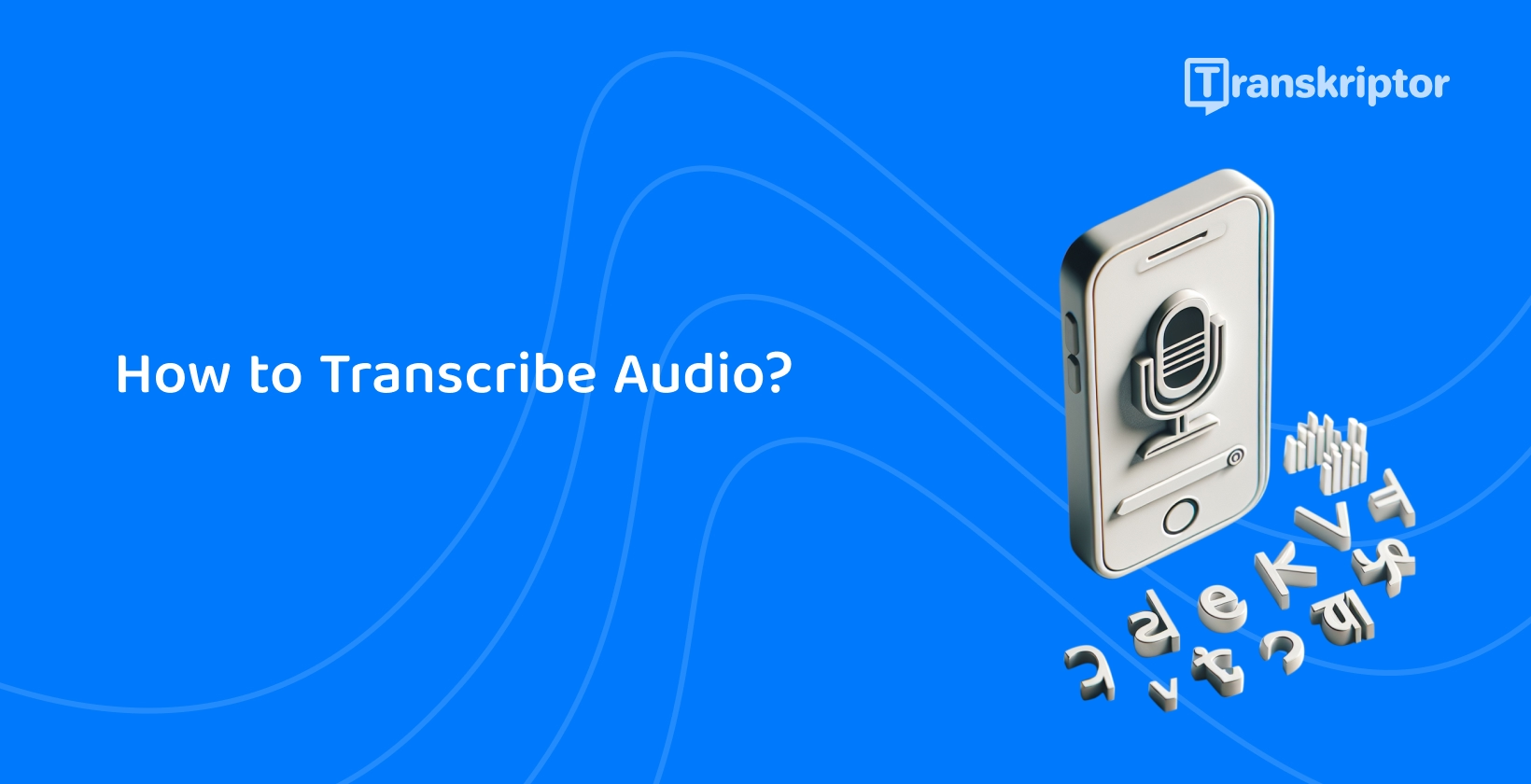Transkriptor ensures precise transcription results with its advanced AI-driven technology, even with complex audio recordings or multiple speakers . Users are able to easily transcribe audio to text with Transkriptor, saving time and effort while achieving professional-quality transcripts.
The 5 steps for transcribing audio with Transkriptor are listed below.
- Sign up or log in to Transkriptor: Create an account or sign in to access Transkriptor's transcription services.
- Upload or record the audio: Import or record your audio file directly within the platform.
- Select the language of your audio: Choose the language spoken in your audio file for accurate transcription.
- Start transcription: Initiate the transcription process with a simple click.
- Edit and save the transcription: Refine and make necessary adjustments to your transcript within the platform. Save your transcript to your device or share it directly from Transkriptor for further use.

Step 1: Sign Up or Log in to Transkriptor
Users must navigate the website and locate the "Login" or "Try it Free" button to access Transkriptor . They should then proceed to create an account or log in.
New users have the option to sign up using their Google or Facebook accounts for convenience, or they should opt to register with their email address. They gain access to the transcription tool and its features once logged in, including uploading audio files for transcription, adjusting settings, and accessing completed transcriptions.
Existing users must simply enter their credentials to access their accounts and resume transcription work seamlessly. Transkriptor ensures a user-friendly experience, prioritizing ease of access and convenience for new and returning users.

Step 2: Upload or Record the Audio
Users are directed to the Transkriptor interface upon logging in, where they locate the "Upload" button. They have to click on this button to initiate the process of uploading audio files for transcription.
Users are provided with the option to select audio files from their device's storage by browsing through their files and folders. They should alternatively opt to record audio directly within the Transkriptor platform using their device's microphone. This feature is handy for transcribers who need to transcribe live conversations or events.
They should confirm their selection and initiate the transcription process after selecting the desired audio file or completing the recording. Transkriptor supports various audio file formats, ensuring compatibility and flexibility for users.
Step 3: Select the Language of Your Audio
Users are able to select the language of their audio recordings from over 100 available languages within the Transkriptor platform. This feature ensures accurate transcription by allowing users to specify the language in their audio recordings.
Transcribers navigate to the language settings section within the Transkriptor interface to select a language. They are able to choose their desired language from the extensive list of options provided. Users should select languages ranging from commonly spoken English, Spanish, or Mandarin to less common languages or dialects.
The ability to select the appropriate language enhances transcription accuracy by enabling Transkriptor to apply language-specific algorithms and recognition models during the transcription process. This ensures that the transcribed text accurately reflects the spoken content of the audio file.
Step 4: Start Transcription
Users initiate the audio transcription process by clicking the "Transcribe" button within the Transkriptor interface upon finalizing their selections. This action triggers Transkriptor's AI algorithms to begin processing the uploaded audio file, utilizing advanced speech recognition technology to generate an accurate transcript.
The time taken for transcription depends on factors such as the length of the audio file and the complexity of the content. Users receive a notification indicating that their transcript is ready for review once the transcription is complete. They should then access the generated transcript within the Transkriptor platform and review the text for accuracy and clarity.

Step 5: Edit and Save the Transcription
Users are able to easily edit all types of transcriptions by logging back into the Transkriptor platform and navigating to the "Transcripts" page. This page provides a range of options for managing their completed transcripts.
They are able to view the entire transcript within the Transkriptor interface, allowing for easy identification of any errors or areas that require revision. Users have the flexibility to make edits directly within the platform using intuitive editing tools provided by Transkriptor. These tools enable transcribers to correct spelling, punctuation, or inaccuracies in the transcript text.
Users should proceed to download or share the completed transcript after editing the transcription to their satisfaction. They should navigate to the "Transcripts" page to find the transcript they wish to download or share.
Users have the option to download the transcript in various file formats, such as text files (e.g., TXT), Word documents (e.g., DOCX), or SRTs. This allows users to choose the format that best suits their needs for further use or distribution.
Transcribers are able to share the transcript directly from the Transkriptor platform with collaborators, clients, or team members. Transkriptor offers convenient sharing options, including email, social media platforms, or direct links. This facilitates seamless communication and collaboration on transcribed content.
Why Choose Transkriptor for Your Audio Transcriptions?
Users should consider Transkriptor for its comprehensive features, customizable options, and AI-driven technology when selecting a platform for audio transcriptions.
Transkriptor offers advanced customization features, allowing users to select from over 100 languages and adjust settings to suit their specific transcription requirements. Its AI-driven technology ensures accurate and efficient results, delivering high-quality transcriptions promptly.
Transkriptor also prioritizes user experience by providing a user-friendly interface and intuitive editing tools, making the transcription process seamless and straightforward. Users also benefit from Transkriptor's flexibility, with options to upload audio files through drag-and-drop, browsing, or pasting web links.
Transkriptor's commitment to security and confidentiality ensures that users' data and transcripts remain protected.
Preparing Your Audio Files: What Do You Need to Know?
Users should prepare files adequately to ensure optimal transcription results before transcribing them. They should start by using high-quality recording devices to capture clear audio. This helps minimize distortion and ensures the speech is easily discernible during transcription.
Transcribers also aim to minimize background noise during recording sessions to improve the clarity of the audio. They should find a quiet environment or use noise-canceling equipment to reduce distractions and interference.
It's also important to save audio files in supported formats compatible with the transcription platform. The platform's specifications must be checked to determine which file formats are recommended for transcription.
Following these preparation steps enhances the accuracy and efficiency of the transcription process, resulting in more reliable and usable transcripts. Properly preparing audio files upfront will save users time and effort during transcription, ultimately leading to better transcription outcomes.
How to Use Transkriptor Like a Pro?
Navigating Transkriptor like a professional streamlines users’ transcription process, ensuring efficient and accurate results. Mastering Transkriptor's features enhances productivity for beginners or seasoned users.
Tip #1: Navigate transcripts easily
Transcribers are able to easily navigate transcripts within Transkriptor using timestamps to locate specific sections of the audio. Timestamps are automatically generated during transcription and synchronized with the corresponding text, allowing users to pinpoint precise moments in the audio recording.
They are able to quickly locate specific sections of interest without having to listen to the entire audio file by leveraging timestamps. This feature is handy for reviewing specific points, verifying accuracy, or referencing particular transcription sections.
Users are also able to click on timestamps within the transcript to play the audio from that exact moment, providing a seamless way to listen to specific segments while following along with the text. Transkriptor's intuitive interface ensures transcribers navigate transcripts effortlessly, enhancing productivity and efficiency during transcription tasks.
Tip #2: Manage large files
Users are able to effectively manage large files in Transkriptor by splitting lengthy audio recordings into smaller, more manageable chunks. These facilitate faster transcription and reduce the likelihood of errors or interruptions during the process by breaking down large files. Transcribers should then upload and transcribe these smaller segments individually, ensuring a smoother and more efficient transcription workflow.
Splitting large files also lets users focus on smaller sections at a time, making maintaining accuracy and consistency throughout the transcription process easier. Users are able to effectively manage large audio files within Transkriptor by adopting this approach, optimizing transcription efficiency and productivity.
Tip #3: Differentiate speakers
Differentiating speakers within Transkriptor allows users to enhance the clarity and organization of their transcripts. This feature is helpful for recordings with multiple speakers, such as interviews, meetings, or panel discussions.
Users should customize speaker labels within the Transkriptor interface to differentiate speakers, assigning unique identifiers to each speaker involved in the recording. These labels will be customized based on the speakers' names, roles, or other relevant identifiers.
Customizing speaker labels allows transcribers to easily distinguish between different speakers throughout the transcript, making it easier to attribute dialogue accurately. This ensures that the transcript reflects the conversation flow and lets users quickly identify who is speaking at any given time. Users also benefit from improved readability and comprehension, especially when reviewing or analyzing the transcript.
Tip #4: Edit and refine
Users should refine their transcripts within Transkriptor using the built-in editor. The editor offers a range of tools for proofreading and punctuating text. It allows transcribers to review the transcript for accuracy and make necessary corrections or adjustments.
They should proofread the text to ensure that it accurately reflects the spoken content of the audio recording, correcting any errors or inaccuracies that have occurred during transcription. Users are also able to punctuate the transcript to improve readability and clarity, inserting punctuation marks such as commas, periods, and quotation marks as needed.
Users are able to refine their transcripts to meet professional standards by utilizing the built-in editor, ensuring that the final product is polished and error-free.
Tip #5: Choose your format
Users have the option to choose their preferred format when exporting transcripts from Transkriptor. This flexibility allows them to select the best format for their needs and preferences.
Common export formats include text files and Word documents, providing users with versatile options for sharing and storing their transcripts. They are also able to export transcripts as SRT subtitle files, which are commonly used for adding subtitles to videos or presentations.
Transkriptor: Best Way to Transcribe Audio
Transkriptor caters to the diverse needs of transcribers across different industries and professions by offering a variety of export formats. Users are able to easily export their transcripts in the desired format with just a few clicks, streamlining the process of sharing and distributing transcribed content.
Ready to streamline your transcription process? Try Transkriptor now and discover how AI-powered technology will revolutionize how you transcribe audio to text.


